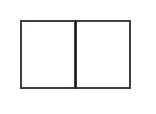我希望自动生成栅格图像的映射类型结果。我能够提供这张图片作为PNG格式: 此图像的原始SVG如下:
此图像的原始SVG如下:
我希望回到
是否有一种方法可以将路径数据转换回我有2个单独的对象的地方?我想能够将结果叠加在原始图像上,并允许针对每个正方形进行定位。
 此图像的原始SVG如下:
此图像的原始SVG如下:<svg width="580" height="400" xmlns="http://www.w3.org/2000/svg">
<g>
<rect fill="#fff" id="canvas_background" height="402" width="582" y="-1" x="-1"/>
<g display="none" overflow="visible" y="0" x="0" height="100%" width="100%" id="canvasGrid">
<rect fill="url(#gridpattern)" stroke-width="0" y="0" x="0" height="100%" width="100%"/>
</g>
</g>
<g>
<rect id="svg_1" height="67" width="54" y="119.5" x="125.5" stroke-width="1.5" stroke="#000" fill="#fff"/>
<rect id="svg_3" height="67" width="54" y="119.5" x="180.5" stroke-width="1.5" stroke="#000" fill="#fff"/>
</g>
</svg>
一旦我使用库进行跟踪:https://github.com/jankovicsandras/imagetracerjs,我会得到这样的路径数据:
<svg width="156" height="114" version="1.1" xmlns="http://www.w3.org/2000/svg" desc="Created with imagetracer.js version 1.2.3" >
<path fill="rgb(60,60,60)" stroke="rgb(60,60,60)" stroke-width="1" opacity="1" d="M 20 20 L 131 20 L 131 89 L 20 89 L 20 20 Z M 22 22 L 22 87 L 74 87 L 74 22 L 22 22 Z M 77 22 L 77 87 L 129 87 L 129 22 L 77 22 Z " />
<path fill="rgb(255,255,255)" stroke="rgb(255,255,255)" stroke-width="1" opacity="1" d="M 0 0 L 156 0 L 156 114 L 0 114 L 0 0 Z M 20 20 L 20 89 L 131 89 L 131 20 L 20 20 Z " />
<path fill="rgb(255,255,255)" stroke="rgb(255,255,255)" stroke-width="1" opacity="1" d="M 22 22 L 74 22 L 74 87 L 22 87 L 22 22 Z " />
<path fill="rgb(255,255,255)" stroke="rgb(255,255,255)" stroke-width="1" opacity="1" d="M 77 22 L 129 22 L 129 87 L 77 87 L 77 22 Z " />
</svg>
我希望回到
rect或多边形方法,这样我就可以测量每个对象的面积,这样如果有追踪文本,我就可以通过说它的总面积低于允许的多边形/矩形对象来排除它/压平它。是否有一种方法可以将路径数据转换回我有2个单独的对象的地方?我想能够将结果叠加在原始图像上,并允许针对每个正方形进行定位。